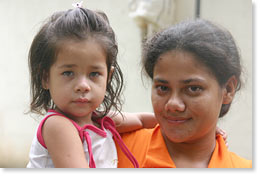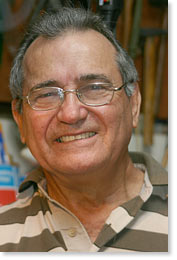|
Interview with Pedro Reyes Millan
Miguel Angel Nuñez, this interview was conducted (and later edited) by Nic Paget-Clarke for In Motion Magazine on September 6, 2004 in Barinas, Barinas state, Venezuela. It was edited by Nic Paget-Clarke in collaboration with Pedro Reyes Millan and Miguel Angel Nuñez. To download a report (Word file-116K) (en español) on the 1st National Conference on Agroecology held in Barinas, December 10-12, 2004 - click here.
From Guerrilla Commander to Taparo Sculptor: Art and Production Models which Transfer Knowledge "Learning means dignity" Barinas, Venezuela
In Motion Magazine: Please say who you are. Pedro Reyes Millan: My name is Pedro Reyes Millan. I am a handicraft artist, an artisan. I believe I find love in the work of hands. To me, handicraft activity is the main thing happening in my life. I was born in a fishing community, on an island called Margarita among a handicraft family. Due to my families values, I learned, since I was a child, how to work with my hands. I made my own tools and tools for others around the village, around the community. It made me highly sensitive to social issues and later in my life I started to protest and fight for have a better quality of life. Working with my hands, to me, is a way to speak, to communicate, to interact with the other people in society, and other artists who also work with their hands. From the work of hands, from that point of view, from that perspective, I am convinced that I contribute to creating a new society, a better society, another possible world. I wish to help my grandsons, granddaughters to give them the opportunity to have another society. I don't want the new generation to grow up in a society that is not humanitarian, which doesn't have justice, and doesn't have any feelings for fraternity, solidarity, freedom. I have been fighting all my life trying to help build a different type of society. The potential of our resources In Venezuela, as in other societies, the people are swimming in a sea where they find many natural resources underutilized. We have natural resources. We have a high biodiversity, we have oil, we have mines, we have people, and we have under-utilized these resources because unfortunately we don't know the potential of our resources. If we knew the potential of the resources our attitude would be different. One of the big advantages that this society has it that it is a pluri-cultural society, a multicultural society, which is linked with many diverse activities, many popular technologies (technologies of the people) that have been forgotten by this society and have been substituted for by an empty technology, an empty type of development that doesn't make any sense. Two production models that increase our dignity When I joined IPIAT, I realized that IPIAT understands two considerations which are to be developed by an NGO, as an institution, to develop action. These two considerations are two models of production -- production activities which deal with the poor people -- one is hand work and the other is agroecology. These two types of activity, to me, are directly related with the poor people, the people that have more needs and thus the possibility to create more, according to the technology that they are using: to work with their hands and also to work agroecology. These two production models, they are not just production models related to making money, related to having a job in order to make money and improving the quality of your life. No, that is not the idea. These types of production models will give you identity, the social identity that we need to keep in front of us in order that we can raise our dignity. Also, these production models allow the farmers, allow handicraft persons, to transfer knowledge between families, between communities, between movements, between social groups, especially families. One big advantage that I realize with my personal experience and experiences I have seen in other countries, is that the head of the family always is re-creating knowledge, always is re-creating some kind of action related to work. I feel relieved, joyful, with the highest dignity, in realizing that I have transferred some knowledge to my children, to the community. These production models allow, they take into consideration, respect, knowledge within the family, between families, within the community. They allow us to have and keep traditional cultural values in the family and in the community. My work is handicraft work. It makes me very happy. I feel dignity because I find that with the more work that I do I find new knowledge in relation to my work. I pick up a piece and I start to work the piece, and I find something different from the piece of wood I was working last night. Always I am learning something. And learning means dignity. To live is to work and act in a creative way. And by creative I mean dreams, emotion, feeling, intuition. When working on a piece of wood, I realize that in working with this piece as a tool I can communicate with other people. I feel that the people will understand what I am trying to say with that piece of wood. And I feel good, comfortable, with dignity, working with this approach. Establish a dialogue with the wood I have learned from one of the main teachers of Simon Bolivar, Simon Rodriguez -- I studied the writings of Simon Rodriguez -- that if I establish, when I am working with a piece of wood, if I establish a dialogue with that piece of wood, that dialogue allows me to improve every day, every hour, more and more. That methodology, the dialogue with the wood, means to me that the first action is going to be checked and corrected by the second. The '60s revolutionary movement In Motion Magazine: Miguel Angel was saying that you used to be a guerilla, a revolutionary, thirty or forty years ago. That you organized in that way. And now you organize farmers with IPIAT and you organize as an artist. How do you see the three being connected? Pedro Reyes Millan: In the past, back in the '60s, there was a very strong revolutionary movement here, very explosive, very competitive, with many bright self-sufficient determinations of what we had to do to take power. We had the influence of the Cuban revolution, the influence of several revolutionary movements. The young people, like me, like many, many, many others -- it was a very strong movement -- they made the decision to transform society in a radical way. Young people, most people, were willing to fight, to organize, to fight to take over the government. I was one of the young people, who when I was nineteen years old, who -- I threw away my job, through away my studies, and went to the revolutionary movement. At that moment, there were great 'get-away' feelings. People weren't taking care of anything else -- families. We were making a self-determined decision to join the revolutionary movement. We went to fight. To organize and fight, though we were convinced it would be difficult to win the fight and take over the government, and besides that to be recognized as the popular movement. That was organizing at that time. Due to my aptitude to be aware, to be going, going, going, I became one of the youngest guerrilla commanders in Venezuela. I became a guerrilla commander at twenty-three years old. I was working mainly as an urban guerrilla. But I went to the mountains and back. Mountains and back. Organizing the guerrilla movement. I was convinced of that decision and very well aware that that type of decision would bring me persecution, torture, and jail. I spent 13 years of my life in jail learning and teaching, working as an artisan. We were convinced that only as guerrillas could we take over the government and make the transformation of society. Only with the full participation of the people But, practice showed to us that we lost. In practice, from the military point of view, we lost the fight. We understood that the society's transformation is possible only with the full participation of the people in the society. That gave to us the understanding that you have to create very close relationships with the people, with the popular movement. Know their needs. Know their expectations. Know their potential. Know everything about the movement. We realized that we didn't have the complete truth about the process that we were involved in. We understood that we had to take into consideration for the transformation the knowledge and the action of the people. That is the main reason that now, today, we try to relate our work with the popular movement. To use our knowledge to work for the needs of society. Needs related to food production, for example. To produce, to grow food. The need to go back to the fields. To work with the farmers. The need to create new technology, appropriate technology, related to that and put it to the service of the population. To the service of the people. I understood that the only way that you can do that is to work at the grassroots level. Work with the people, in the center of the people, in the heart of the popular movement. That is the big difference between the '60s and the situation we are in now. In Motion Magazine: And how is that then connected to your art? Pedro Reyes Millan: I believe what we are doing today is perfectly linked with the past. With the production of art important contributions are made to the transformation of society. If we are convinced that what has to do with the past and also what we are doing now can help make the transformation of the Venezuelan society -- then we should be able to transform society. My conceptualization of art is art is for life. Work for life, be life, give life -- so that the people will feel life. Published in In Motion Magazine December 10, 2004. Also see:
|
If you have any thoughts on this or would like to contribute to an ongoing discussion in the  What is New? || Affirmative Action || Art Changes || Autonomy: Chiapas - California || Community Images || Education Rights || E-mail, Opinions and Discussion || En español || Essays from Ireland || Global Eyes || Healthcare || Human Rights/Civil Rights || Piri Thomas || Photo of the Week || QA: Interviews || Region || Rural America || Search || Donate || To be notified of new articles || Survey || In Motion Magazine's Store || In Motion Magazine Staff || In Unity Book of Photos || Links Around The World NPC Productions Copyright © 1995-2018 NPC Productions as a compilation. All Rights Reserved. |








